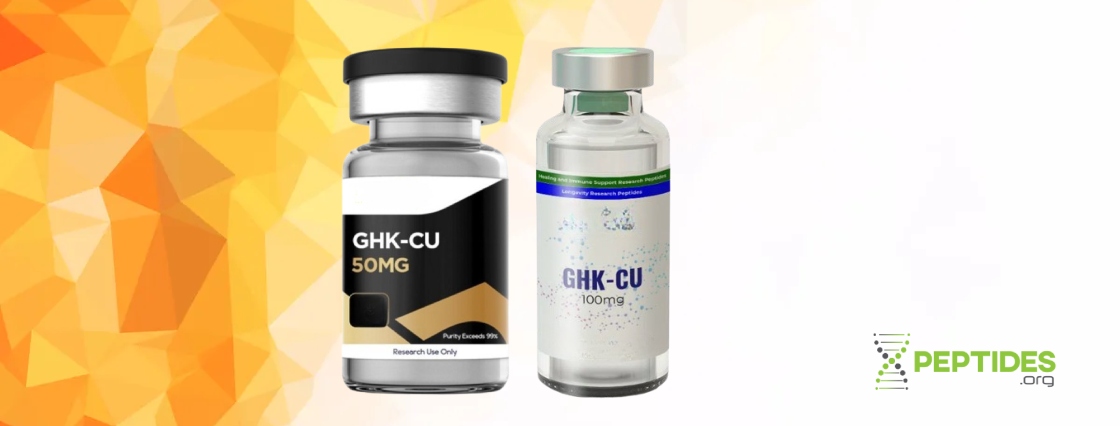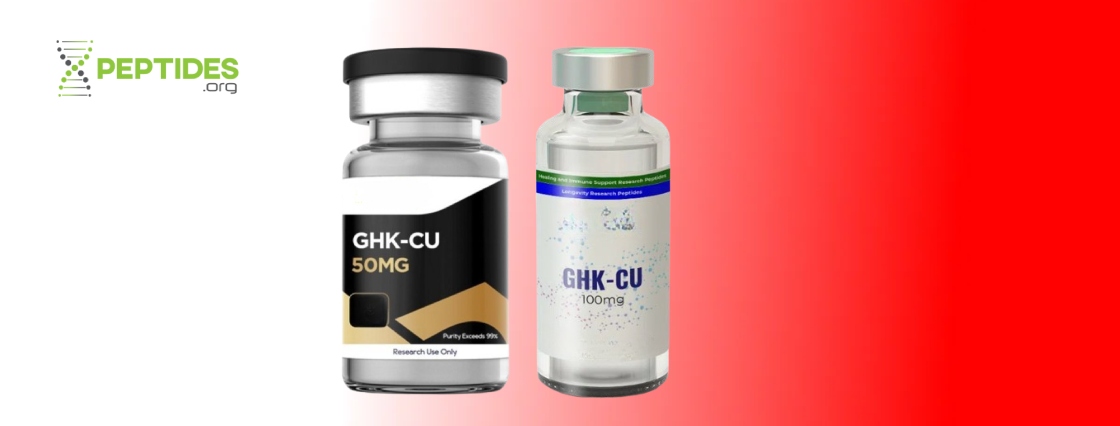Compound Overview
Class of Compound:
Peptide
Mechanism of Action:
GHK-Cu is said to stimulate the synthesis and breakdown of collagen and glycosaminoglycans, as well as modulating the activity of metalloproteinases and their inhibitors. It is also believed to stimulate dermatan sulfate, chondroitin sulfate, and decorin, and acts to attract immune and endothelial cells to sites of injury.
Notable Studies:
Also Known As:
Glycyl-L-Histidyl-L-Lysine; Growth-modulating peptide, Kollaren, Liver cell growth factor, Liver growth factor Cu-GHK, Glycyl-histidyl-lysine, monocopper salt
Research Applications:
- Wound healing
- Nerve regeneration
- Hair growth
- Anti-aging
- DNA repair
Risks:
- Mechanisms still not fully understood
- No FDA review or approval
- Many counterfeits online
Chemical Structure

What is GHK-Cu?
GHK-Cu is a human copper-binding peptide proven to confer a host of benefits related to healing, tissue regeneration, and skin, hair, and nail health.
GHK was first discovered in 1973 by the noted peptide researcher Dr. Loren Pickart. He found that aged liver cells, when inoculated with blood from young people, were able to begin regenerating [1].
Eventually, it was discovered that GHK was the cause of this spontaneous regeneration. This is also how researchers were able to discover that GHK declined during the aging process, since the aged cells were not able to begin regeneration until introduced to young blood cells.
Since this discovery, GHK-Cu has been widely used in topical anti-aging skincare products and hair regrowth formulations. It also shows strong potential in more therapeutic applications from pain reduction to nervous system function, although research is ongoing at this time.
Here is what researchers need to know about GHK-Cu.

What Does GHK-Cu Do?
GHK-Cu (glycyl-l-histidyl-l-lysine-copper) is a copper-binding human peptide found in cell plasma, saliva, and urine. It is also known as copper tri-peptide, and when not bound with copper it is referred to as GHK. Levels of GHK-Cu in the body naturally decline during aging [2].
GHK-Cu’s primary function is one of healing and antioxidative effects, and researchers attribute much of its beneficial effect to its ability to bind with copper ions. This allows it to play an important role in copper metabolism, and the essential mineral copper plays many key roles in human health [3].
However, GHK-Cu may also — unrelated to its copper-binding capacity — upregulate and downregulate a number of genes that play roles in skin repair, healing, and blood vessel and nerve growth [3].
GHK-Cu Benefits | Clinical Trials
GHK-Cu appears to have two main methods of action. It can upregulate and downregulate over 4,000 genes, and its copper binding properties also exert many positive effects [2].
Here are some of the potential and most promising benefits of GHK-Cu:
Tissue healing: GHK-Cu was first discovered after researchers found that blood from younger volunteers could promote regeneration of aged and injured liver cells, so the compound has clear potential in tissue healing, injury recovery, and cell regeneration [1].
Preliminary animal and test-tube studies have noted that GHK-Cu liposomes promoted the proliferation of healthy cells, and increased the rate of scald wound healing in mice [4].
Researchers also found that GHK-Cu injections could help mice recover more quickly from anterior cruciate ligament (ACL) reconstruction surgery by promoting tissue remodeling and growth of the graft (where the new tissue meets the old tissue), which tends to be the “weakest link” in recovery from such operations [5].
Skin quality: In addition to wound healing properties that can act on the skin, GHK-Cu may provide numerous other benefits for the skin — which is why it is a popular ingredient in anti-aging creams and other skin care products.
The peptide promotes collagen synthesis and breakdown, so in essence it may help the skin “recycle” old cells to replace them with healthier new ones [2].
In cosmetics and topical applications, GHK-Cu may help promote tightening of loose skin, skin elasticity and firmness, wrinkle reduction, and photoprotection (mitigation of sun damage). It may also help reduce the appearance of hyperpigmentation, or sun spots [2].
Antioxidant effects: Many of GHK-Cu’s positive effects likely come from its antioxidant capacity. As an antioxidant, GHK-Cu can neutralize free radicals, which cause oxidative damage to the cells.
At a cellular level, this promotes more productive and healthy mitochondria, helping the cell to function more optimally, reducing systemic inflammation, and promoting healthy cell turnover [6, 7, 8, 9, 10].
Hair growth: GHK-Cu may also promote the regrowth and restoration of hair follicles, contributing to hair regrowth and thickening. The peptide is an ingredient in some hair growth formulations.
One study investigating a complex of 5-aminolevulinic acid and GHK together found a dose-dependent response on hair count to this complex. The men taking the highest dose had the highest increases in hair count, while the men taking a placebo had the lowest increases in hair count [11].
This promising research shows that GHK-Cu may be effective for men experiencing male pattern baldness.
Anxiety: GHK may also offer anxiolytic, or anxiety-reducing, benefits. In a rat study, researchers noted that GHK administration prior to a maze test resulted in a reduction in apparent anxiety in the mice.
Curiously, the strongest anxiolytic effect came from the smallest administered dose of 0.5 mcg/kg body weight, whereas larger doses had smaller effects on anxiety [12].
Buy GHK-Cu from our top-rated vendor...

GHK-Cu Side Effects
GHK-Cu is a naturally-occurring substance found in the body, and GHK-Cu treatment appears to be mostly safe. Dr. Loren Pickart, the researcher responsible for its original isolation, has stated that in his numerous studies on GHK, “no issues have ever arisen during its use as a skin cosmetic or in human wound healing studies [13].”
But that is not to say that GHK-Cu is completely without side effects. One noted side effect related to its anxiolytic effect is that it can reduce blood pressure levels. In high enough doses, this can be dangerous and potentially fatal [6].
However, researchers estimate that the lethal dose of GHK-Cu would be about 330 mg/kg of body weight, which is over 300 times larger than its known effective dose. Still, this data point is something to be aware of when designing research studies [6].
Is GHK-Cu Safe?
GHK-Cu has not been approved for any therapeutic use in humans by the United States Food and Drug Administration (FDA), nor by any of its international regulatory counterparts. Accordingly, researchers should evaluate claims or statements regarding GHK-Cu’s safety with due caution.
Researchers should note that despite GHK-Cu’s favorable safety profile, the subcutaneous or intramuscular administration of peptides in general is associated with injection site pain, lightheadedness, nausea, and even flu-like symptoms in subjects.
Injectable GHK-Cu should always be administered with due caution and only by qualified researchers or laboratory professionals.
Where GHK-Cu is available as part of a cream or topical that may be purchased over-the-counter, it should be applied as directed.
GHK-Cu Dosage Calculator
For the most part, GHK-Cu appears to be safe. However, there are not yet any firm dosing recommendations in therapeutic contexts.
According to Dr. Pickart, a total treatment dosage of 100-200mg of GHK injected intramuscularly may provide health benefits to subjects [13]. However, researchers have also noted that a total treatment dose of 1.1 mg/kg body weight was able to produce similar positive effects [13].
For liposomal oral tablets, which contain a protective buffer of fatty acids that resist degradation and destruction, researchers recommend a starting dose of 10 mg, but this may be too small of a dose to see positive effects [14, 15].
The most common injectable dose for research purposes appears to be 1-2 mg per day over a thirty-day treatment course. This starting dose may be titrated up if needed, but it’s always prudent to stick with the lowest effective dose.
Skin creams and topical products containing GHK-Cu should be applied as needed.
Where to Buy GHK-Cu Online? | 2024 Edition
Qualified researchers and laboratory professionals may purchase GHK-Cu online in either injectable or topical cream format for experimentation.
At Peptides.org, we have extensively surveyed the peptide industry to present our readers with the best supplier of GHK-Cu today.
Limitless Life
We highly recommend using Limitless Life to supply peptides for any upcoming research projects.
This is because they are committed to product quality. They also offer an excellent reship/return policy backed by their satisfaction guarantee, they partner with researchers to ensure that peptides are distributed safely, and they have a reputation for being credible and trustworthy.
Below, we’ve discussed each of these deciding factors in further detail:
- Third-Party Tested Peptides: Through partnerships with three independent laboratories, Limitless Life can offer research peptides with a purity rating of at least 99% — setting a new standard in the peptide industry.
- Excellent Return and Reship Policy: Limitless Life’s commitment to satisfaction is illustrated by their easy reship and return processes, as well as their offer of affordable shipping insurance with each order to cover lost or damaged packages.
- Responsible Partnerships with Researchers: Research peptide products are intended only for use by qualified peptide researchers. Limitless Life emphasizes this fact at several points on their website to help promote the safe distribution of research peptides.
- Credible and Reputable: Thanks to their low rate of credit card charge-backs and high customer ratings on third-party review sites, Limitless Life has earned a reputation as a trustworthy peptide vendor.
- Capsules Formulations: Limitless Life also offers unique peptide products, like GHK-Cu capsules for research.
Not to mention, qualified peptide researchers can receive a 10% discount on their next Limitless Life order using our discount code. Click the button below and then add the following code:
peptidesorg10
Buy GHK-Cu from our top-rated vendor...

Bacteriostatic Water and GHK-Cu
While a quality supply of GHK-Cu is essential, researchers can’t neglect the importance of ancillary supplies for safe and effective peptide handling.
Lab tools like bacteriostatic water, sterile vials, and insulin syringes are non-negotiable for the proper reconstitution and storage of research peptides.
While getting a hold of all these essentials may be challenging for some researchers, requiring hours of web searches and multiple purchases from retailers of questionable quality, it is required.
Most research labs will require these materials when handling peptides:
- Bacteriostatic Water
- Insulin Syringes
- Alcohol Prep Pads
- Sterile Empty Glass Vial
- Large Needles + Syringes Combo
If a researcher is not sure where to source said supplies and materials, checking with authorized vendors is recommended.
FAQ
GHK-Cu | Reviews
GHK-Cu is a copper binding tripeptide. It was first isolated in 1973 when researchers noted its powerful cell regenerating capacity in experiments with liver cells. It gains its effectiveness from both its ability to bind with copper and its ability to up and down-regulate a minimum of 4,000 different genes.
It has been proven to offer tissue healing, anti-anxiety, and antioxidant effects, and offers skin and hair benefits as well. GHK-Cu is now used in several topical anti-aging creams and hair loss solutions.
Researchers typically start with a daily dose of 1-2 mg of GHK-Cu, administered subcutaneously, for an experiment duration of 30 days. GHK-Cu appears to be safe, although extremely high doses may drop blood pressure to dangerously low levels.
GHK-Cu is available in topical products, but in its isolated form it is only legal to possess for research purposes. In the latter form, it is not produced for human ingestion or unsupervised self-administration.
For researchers looking to purchase GHK-Cu, we recommend our top-rated vendor here.

References
- Pickart L, Thayer L, Thaler MM. A synthetic tripeptide which increases survival of normal liver cells, and stimulates growth in hepatoma cells. Biochem Biophys Res Commun. 1973;54(2):562-566. doi:10.1016/0006-291x(73)91459-9
- Pickart L, Vasquez-Soltero JM, Margolina A. GHK Peptide as a Natural Modulator of Multiple Cellular Pathways in Skin Regeneration. Biomed Res Int. 2015;2015:648108. doi:10.1155/2015/648108
- Pickart L, Margolina A. Regenerative and Protective Actions of the GHK-Cu Peptide in the Light of the New Gene Data. Int J Mol Sci. 2018;19(7):1987. Published 2018 Jul 7. doi:10.3390/ijms19071987
- Wang X, Liu B, Xu Q, et al. GHK-Cu-liposomes accelerate scald wound healing in mice by promoting cell proliferation and angiogenesis. Wound Repair Regen. 2017;25(2):270-278. doi:10.1111/wrr.12520
- Fu SC, Cheuk YC, Chiu WY, Yung SH, Rolf CG, Chan KM. Tripeptide-copper complex GHK-Cu (II) transiently improved healing outcome in a rat model of ACL reconstruction. J Orthop Res. 2015;33(7):1024-1033. doi:10.1002/jor.22831
- Pickart L, Vasquez-Soltero JM, Margolina A. The human tripeptide GHK-Cu in prevention of oxidative stress and degenerative conditions of aging: implications for cognitive health. Oxid Med Cell Longev. 2012;2012:324832. doi:10.1155/2012/324832
- Ma WH, Li M, Ma HF, et al. Protective effects of GHK-Cu in bleomycin-induced pulmonary fibrosis via anti-oxidative stress and anti-inflammation pathways. Life Sci. 2020;241:117139. doi:10.1016/j.lfs.2019.117139
- Park JR, Lee H, Kim SI, Yang SR. The tri-peptide GHK-Cu complex ameliorates lipopolysaccharide-induced acute lung injury in mice. Oncotarget. 2016;7(36):58405-58417. doi:10.18632/oncotarget.11168
- Sakuma S, Ishimura M, Yuba Y, Itoh Y, Fujimoto Y. The peptide glycyl-ʟ-histidyl-ʟ-lysine is an endogenous antioxidant in living organisms, possibly by diminishing hydroxyl and peroxyl radicals. Int J Physiol Pathophysiol Pharmacol. 2018;10(3):132-138. Published 2018 Jun 25.
- Gruchlik A, Jurzak M, Chodurek E, Dzierzewicz Z. Effect of Gly-Gly-His, Gly-His-Lys and their copper complexes on TNF-alpha-dependent IL-6 secretion in normal human dermal fibroblasts. Acta Pol Pharm. 2012;69(6):1303-1306.
- Lee WJ, Sim HB, Jang YH, Lee SJ, Kim do W, Yim SH. Efficacy of a Complex of 5-Aminolevulinic Acid and Glycyl-Histidyl-Lysine Peptide on Hair Growth. Ann Dermatol. 2016;28(4):438-443. doi:10.5021/ad.2016.28.4.438
- Bobyntsev II, Chernysheva OI, Dolgintsev ME, Smakhtin MY, Belykh AE. Anxiolytic effects of Gly-His-Lys peptide and its analogs. Bull Exp Biol Med. 2015;158(6):726-728. doi:10.1007/s10517-015-2847-3
- Pickart L, Vasquez-Soltero JM, Margolina A. GHK and DNA: resetting the human genome to health. Biomed Res Int. 2014;2014:151479. doi:10.1155/2014/151479
- Erdem S, Turkoglu M. Glycyl-l-histidyl-l-liysine-Cu(2+) loaded liposome formulations. Marmara Pharm J. 2010;14:91-97. doi:10.12991/201014455
- Pickart L, Vasquez-Soltero JM, Margolina A. The Effect of the Human Peptide GHK on Gene Expression Relevant to Nervous System Function and Cognitive Decline. Brain Sci. 2017;7(2):20. Published 2017 Feb 15. doi:10.3390/brainsci7020020
